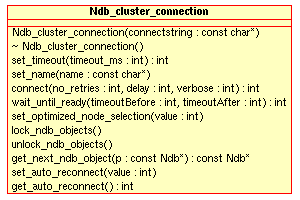- 2.3 NDB API Classes, Interfaces, and Structures
- 2.3.1 The Column Class
- 2.3.2 The Datafile Class
- 2.3.3 The Dictionary Class
- 2.3.4 The Event Class
- 2.3.5 The Index Class
- 2.3.6 The LogfileGroup Class
- 2.3.7 The List Class
- 2.3.8 The Ndb Class
- 2.3.9 The NdbBlob Class
- 2.3.10 The NdbDictionary Class
- 2.3.11 The NdbEventOperation Class
- 2.3.12 The NdbIndexOperation Class
- 2.3.13 The NdbIndexScanOperation Class
- 2.3.14 The NdbInterpretedCode Class
- 2.3.15 The NdbOperation Class
- 2.3.16 The NdbRecAttr Class
- 2.3.17 The NdbScanFilter Class
- 2.3.18 The NdbScanOperation Class
- 2.3.19 The NdbTransaction Class
- 2.3.20 The Object Class
- 2.3.21 The Table Class
- 2.3.22 The Tablespace Class
- 2.3.23 The Undofile Class
- 2.3.24 The Ndb_cluster_connection Class
- 2.3.25 The NdbRecord Interface
- 2.3.26 The AutoGrowSpecification Structure
- 2.3.27 The Element Structure
- 2.3.28 The GetValueSpec Structure
- 2.3.29 The IndexBound Structure
- 2.3.30 The Key_part_ptr Structure
- 2.3.31 The NdbError Structure
- 2.3.32 The OperationOptions Structure
- 2.3.33 The PartitionSpec Structure
- 2.3.34 The RecordSpecification Structure
- 2.3.35 The ScanOptions Structure
- 2.3.36 The SetValueSpec Structure
Abstract
This class represents a connection to a cluster of data nodes.
Parent class. None
Child classes. None
Description.
An NDB application program should begin with the creation of a
single Ndb_cluster_connection object, and
typically makes use of a single
Ndb_cluster_connection. The application
connects to a cluster management server when this object's
connect() method is called. By using the
wait_until_ready() method it is possible to
wait for the connection to reach one or more data nodes.
Note
There is no restriction against instantiating multiple
Ndb_cluster_connection objects representing
connections to different management servers in a single
application, nor against using these for creating multiple
instances of the Ndb class. Such
Ndb_cluster_connection objects (and the
Ndb instances based on them) are not required
even to connect to the same cluster.
For example, it is entirely possible to perform
application-level partitioning of data in
such a manner that data meeting one set of criteria are
“handed off” to one cluster via an
Ndb object that makes use of an
Ndb_cluster_connection object representing a
connection to that cluster, while data not meeting those criteria
(or perhaps a different set of criteria) can be sent to a
different cluster through a different instance of Ndb that makes
use of an Ndb_cluster_connection
“pointing” to the second cluster.
It is possible to extend this scenario to develop a single application that accesses an arbitrary number of clusters. However, in doing so, the following conditions and requirements must be kept in mind:
A cluster management server (ndb_mgmd) can connect to one and only one cluster without being restarted and reconfigured, as it must read the data telling it which data nodes make up the cluster from a configuration file (
config.ini).-
An
Ndb_cluster_connectionobject “belongs” to a single management server whose host name or IP address is used in instantiating this object (passed as theconnectstringargument to its constructor); once the object is created, it cannot be used to initiate a connection to a different management server.(See Section 2.3.24.1.1, “
Ndb_cluster_connectionClass Constructor”.) -
An
Ndbobject making use of this connection (Ndb_cluster_connection) cannot be re-used to connect to a different cluster management server (and thus to a different collection of data nodes making up a cluster). Any given instance ofNdbis bound to a specificNdb_cluster_connectionwhen created, and thatNdb_cluster_connectionis in turn bound to a single and unique management server when it is instantiated. The bindings described above persist for the lifetimes of the
NdbandNdb_cluster_connectionobjects in question.
Therefore, it is imperative in designing and implementing any
application that accesses multiple clusters in a single session,
that a separate set of Ndb_cluster_connection
and Ndb objects be instantiated for connecting
to each cluster management server, and that no confusion arises as
to which of these is used to access which MySQL Cluster.
It is also important to keep in mind that no direct “sharing” of data or data nodes between different clusters is possible. A data node can belong to one and only one cluster, and any movement of data between clusters must be accomplished on the application level.
For examples demonstrating how connections to two different clusters can be made and used in a single application, see Section 2.4.2, “Using Synchronous Transactions and Multiple Clusters”, and Section 2.4.8, “Event Handling with Multiple Clusters”.
Methods. The following table lists the public methods of this class and the purpose or use of each method:
| Method | Purpose / Use |
|---|---|
Ndb_cluster_connection() |
Constructor; creates a connection to a cluster of data nodes. |
set_name() |
Provides a name for the connection |
set_timeout() |
Sets a connection timeout |
connect() |
Connects to a cluster management server. |
wait_until_ready() |
Waits until a connection with one or more data nodes is successful. |
set_optimized_node_selection() |
Used to control node-selection behavior. |
lock_ndb_objects() |
Disables the creation of new |
unlock_ndb_objects() |
Enables the creation of new |
get_next_ndb_object() |
Used to iterate through multiple |
set_auto_reconnect() |
Enables or disables auto-reconnection of API nodes using
this |
get_auto_reconnect() |
Gets the auto-reconnection setting for API nodes using
this |
For detailed descriptions, signatures, and examples of use for each
of these methods, see
Section 2.3.24.1, “Ndb_cluster_connection Methods”.
Class diagram.
This diagram shows all the available methods of the
Ndb_cluster_connection class:

